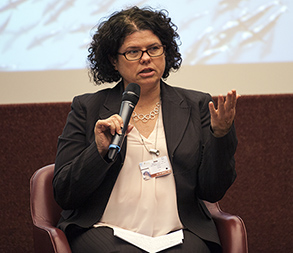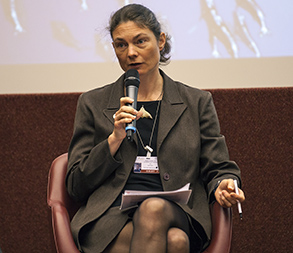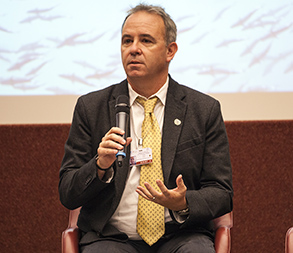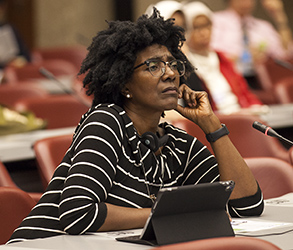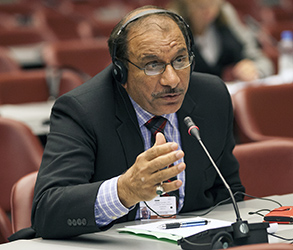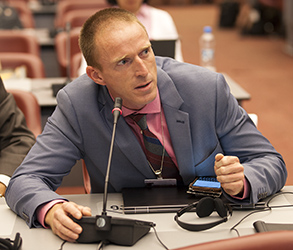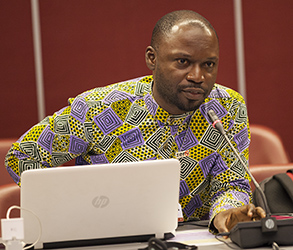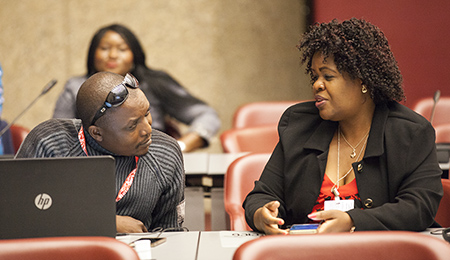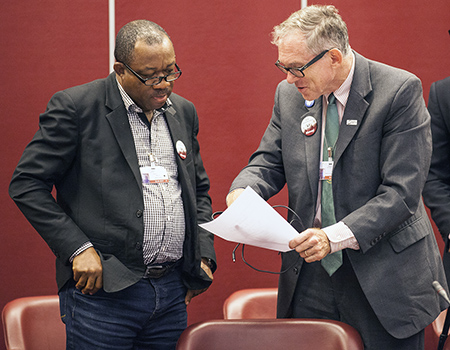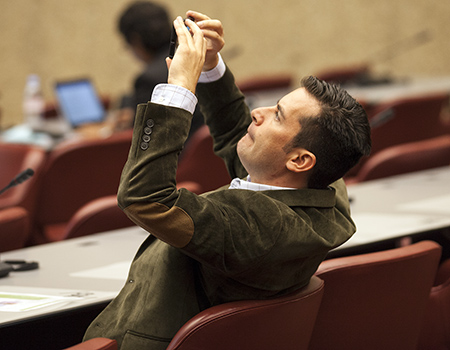Summary
Eisaku Toda, interim Secretariat of the Minamata Convention, opened the session, highlighting that the results of the three thematic sessions on land, air and water will inform the high-level ministerial roundtable of COP1.
Achim Halpaap, UN Environment, moderated the session. He said that human activities since the industrial revolution have tripled mercury concentrations in the biosphere. He stressed that water bodies are the main repositories of mercury. Noting the complexities of mercury clean-up, Halpaap identified liability as an issue in remediating the legacy of mercury pollution. Halpaap then posed questions to the panelists including on the: impacts of mercury pollution on marine biota; role of modifying consumption practices to reduce mercury exposure; impacts of biomagnification of mercury on health and the environment; technologies to reduce mercury releases; and integration of scientific findings into policy-making.
Imogen Ingram, Island Sustainability Alliance, Cook Islands, noted that subsistence fishing is the basis of dietary protein in many Pacific islands. She identified high concentrations of mercury in Pacific island populations, with over 90% of sampled women having mercury above 2.5ppm, with some registering up to 7ppm. She stressed that there are no major emissions of mercury in the Pacific islands, and said that the mercury present in fish comes from other parts of the world. Ingram emphasized the challenges of translating scientific knowledge on mercury and its effects on health and the environment, to local populations. Noting that education is key, she stressed the need to produce advisories adapted to the eating habits of each island. In general, Ingram said, the bigger the fish, the higher the mercury concentration.
Eva Kruemmel, Inuit Circumpolar Council, noted mercury impacts in the Arctic are similar to those in Pacific islands. She said Inuit peoples are particularly exposed to mercury because of their diet, with women of childbearing age exceeding safety guidelines by 50-90%. She explained mercury presence in Inuit populations has led to negative cognitive impacts. She noted the seasonality of mercury exposure, according to hunting seasons, emphasizing that for many Inuit communities, marine protein is the only source of food. Kruemmel stressed the importance of working with people and communities. She underlined that while the first line of defense against mercury exposure is to reduce consumption of contaminated fish, the best solution is not to pollute in the first place.
David Evers, Biodiversity Research Institute, noted that when elemental mercury is released from anthropogenic sources, it is still not toxic, but has to first transform into methyl mercury. This happens in wet or moist environments, where bacteria process it. Then, he said, mercury can enter the food chain and bioaccumulate. He noted that there are many fish with low concentrations of mercury, but cited the problem as being present in the high trophic-level fish. Evers noted that some segments of society face higher risks, such as children and child-bearing women, than others. He emphasized it is very complex to determine cumulative exposure of individuals due to the many factors involved.
Susan Keane, National Resources Defense Council, emphasized that the mercury emissions of artisanal and small-scale gold mining (ASGM) include emissions to both air and water, with the biggest impact being on water. She emphasized that ASGM is not just a mercury problem, but a socioeconomic and environmental problem with large impacts, such as extreme erosion, deforestation, and exacerbated water scarcity, of which mercury use is only a symptom. Keane said that even though each operation may be small, overall, AGSM is a large problem. She highlighted food security and neurological impacts for communities downstream from mining operations. Keane emphasized that there are technical solutions for ASGM, but that it is necessary to establish appropriate policies and frameworks for technology deployment.
Judith Torres, Environment Ministry, Uruguay, explained Uruguay’s efforts to identify the primary mercury emission sources and to elaborate a national inventory, as well establishing control measures. She said a chloralkali plant, and waste from products containing mercury were the main mercury sources in Uruguay.
Following the panel’s interventions, there was an open discussion with the public. Issues addressed included: identification of mercury hotspots; use of hair and other sampling techniques for measuring mercury concentrations in human bodies; use of fish size-based mercury health advisories; gold recovery rates from mercury and cyanide processes, versus mechanical processes; novel approaches for ASGM including the use of fungi; the role of dental practices in releases of mercury to water; toxicity of elemental mercury versus methylmercury; the ban of mercury imports; and step-by-step approaches in reducing mercury exposure.
IISD Reporting Services, through its ENB+ Meeting Coverage, is providing daily web coverage from the Thematic Sessions at Mercury COP1.
Photos by IISD/ENB+ | Mike Mizurakis
For photo reprint permissions, please follow instructions at our Attribution Regulations for Meeting Photo Usage Page.
From L-R: Achim Halpaap, UN Environment; Eva Kruemmel, Inuit Circumpolar Council; Imogen Ingram, Island Sustainability Alliance; David Evers, Biodiversity Research Institute; Susan Keane, National Resources Defense Council; and Judith Torres, Environment Ministry, Uruguay
Susan Keane, National Resources Defense Council
Eva Kruemmel, Inuit Circumpolar Council
David Evers, Biodiversity Research Institute
Achim Halpaap, UN Environment
Imogen Ingram, Island Sustainability Alliance
Eisaku Toda, Minamata Secretariat
Judith Torres, Environment Ministry, Uruguay
September Williams, Filmmaker
Mahmood Khwaja, Sustainable Development Policy Institute (SDPI)
Pam Clark, International Dental Manufacturers (IDM)
Damir Skripec, International Academy of Oral Medicine and Toxicology (IAOMT)
Gilbert Kuepouo, Centre de Recherche et d'Education Pour le Développement (CREPD)
Solomon Kusi Ampofo, Friends of the Nation, Ghana
The list of countries that have ratified the Minamata Convention on Mercury as of September 2017

